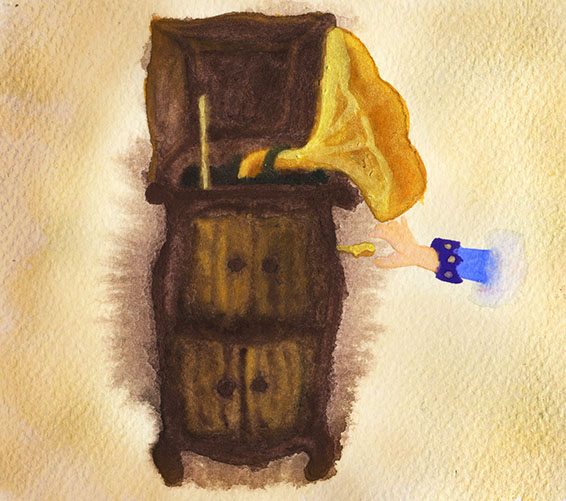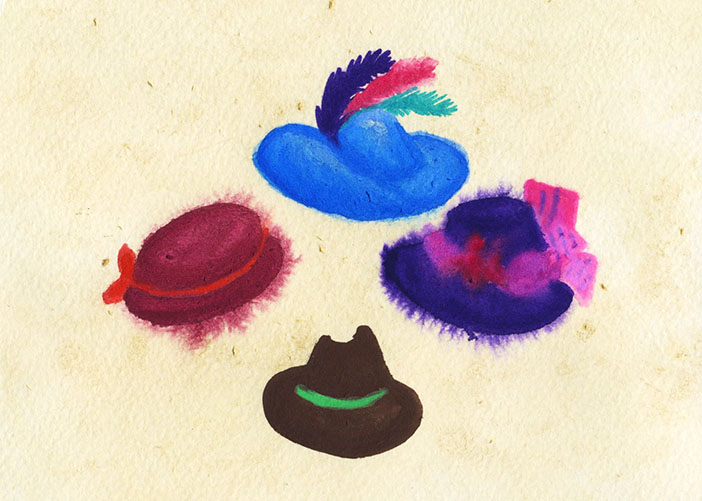Regal best describes the way the house made me feel — like a princess. The first time my family toured the inside, I felt the fanciest a ten-year-old girl could feel as I slowly and dramatically clutched the polished oak banister and sauntered down the winding staircase into the mansion’s brightly lit foyer. A combination of Queen Anne, Neoclassical, and Gothic architecture, the Allen House was a true masterpiece. The house wasn’t for sale when we moved to Monticello, Arkansas, in 2005, but we drove by numerous times to admire its grandeur. My stepmother, Rebecca, fell in love with its behemothic pillars, the ivy that slithered up the chipping white paint of the circular Victorian-style turrets, and the maroon spires atop the turrets that proudly framed the iron-railed widow’s walk. She somehow cajoled the owner into selling it to us the summer of 2007. What we didn’t realize was that we would be moving into the crypt of a haunted love story.
Locals seemed to know the house was haunted, but they could never agree on the story of why. My dad, who had just started a deanship at the local university, shrugged off the superstitious warnings and tales until we started having our own experiences. After moving in, for a week straight, he found a broken glass in the kitchen each morning, and our antique Victrola — an upright phonograph from the early 1900s, much like a record player — would sometimes crank and play on its own. Then, there were the strange interactions we had with my little brother Jacob, who was about five years old at the time — but Jacob would be on a completely different floor of the house when the interaction occurred. For example, at breakfast one morning, everyone was crowded in the kitchen, quietly filling glasses of orange juice and mustering the energy to be functional human beings. Suddenly, Jacob darted out of the kitchen and into the bathroom down the hall. After a few minutes, Rebecca went to check on him, and from behind the locked door, he dryly responded, “I’m doing things in here.” Rebecca retreated to the kitchen to inspect the bacon crackling on the stove and then returned to find the door open and the bathroom empty. My dad found Jacob upstairs in his room watching television. He asked him why he hadn’t come back to the kitchen. Jacob confusedly replied that he had been upstairs the entire time and had just recently woken up. He wasn’t hungry. Paranormal experts describe this phenomenon as Doppelgänger activity, in which a spirit manifests itself as a living person, like a double. The rise in activity around the house piqued my dad’s interest in a way nothing had before, and so began the search for understanding the history of our new home.

Joe Lee Allen, a wealthy entrepreneur, had the house built for his family in 1906. He was the first president of Commercial Bank, sold Monticellonians the first Buicks, owned a livery stable and the Allen Hotel, and wore many other hats. He was well-known and well-respected throughout southeast Arkansas, and his children were no strangers to the spotlight either. Of Joe Lee’s three daughters, his middle daughter Ladell was his favorite. He even named a town after her in 1912 when she was 18 years old. Locals assumed with a family like hers, Ladell lived a prosperous and happy life, but she disproved that notion with her attempted suicide in the master bedroom suite on Christmas night, 1948.
My stepmother obtained a copy of Ladell’s death certificate, which confirmed the cause of death as mercury cyanide poisoning. Although cyanide is a fast-acting poison, Ladell did not die until a week later on January 2, 1949, suffering in the hospital as the poison crept through her bloodstream, possessing each cell, demanding it no longer acquire oxygen. This reaction resulted in a chemical strangulation that would first affect her central nervous system and cause vertigo, sensory impairment, and confusion. Her heart no doubt pounded with the vivacity of a hummingbird’s wings; her breathing grew shallow, and she spiraled into a series of tremors and convulsions; and finally, she entered a deep comatose phase until her body could no longer combat the sluggish traitor.
Ladell’s obituary in the Advance Monticellonian describes Ladell as “possessed of a charming personality and lovable disposition, she believed that to be loved was to love others. She practiced her philosophy of life in her everyday living, never feeling that anything was too hard for a friend.” The cause of death was not specified in the paper and was kept a secret by her family, and everyone remained puzzled about Ladell’s motives for killing herself. Ladell’s mother, Caddye, sealed off the master bedroom suite as a memorial to her daughter, and no one entered the room for more than 35 years. When the house was purchased by the Painton family in 1985, the room was unsealed. A bottle of cyanide, a small plate, and a glass awaited them on a closet shelf — although it wasn’t until August 22, 2009, that Ladell’s secret was revealed.
That morning, my dad awoke and felt compelled to rummage through the attic. He hiked up the steep, groaning steps and straight to a spot he had walked past many times before where a small opening in the floorboard was just barely visible. Inside, he discovered a sack of more than 90 letters, most of which were written between Ladell and a man named Prentiss Hemingway Savage. Prentiss had been her high school sweetheart until he moved away in 1913. The letters tell the story of how Ladell and Prentiss bumped into each other at the horse races in Hot Springs in March 1948 while Prentiss and his wife were visiting family in Arkansas. Ladell, Caddye, Prentiss, and his wife enjoyed a raccoon dinner together, and once Prentiss returned to his home in Minneapolis, he began writing to Ladell — his “dear Dell.” The two sparked a great love affair. In July, they met in Minnesota for a secret tryst — a “business trip” as Prentiss told his secretary. They schmoozed each other and meandered through the midwestern states together for three weeks. Prentiss swore to Ladell that he would leave his wife and they would live happily ever after, but in October of that year, Prentiss wrote a contradictory letter. Prentiss realized if he left his wife, she would take all his money — something he had a lot of as the vice president of Texaco Oil. Ladell desperately pleaded for their relationship to work, but responses from Prentiss seldom arrived. She invited Prentiss to her family’s annual Christmas party, likely hoping he would show up and their romance would take off again, but he didn’t show. And so, a heartbroken Ladell prepared a plate of hors d’oeuvres and a glass of punch and then retreated to the master bedroom with a bottle of mercury cyanide tablets.

Before my dad found the letters, many people speculated that Ladell’s death was due to mourning her son Allen’s passing from pneumonia four years prior, although they had not had a very close relationship. She had also had a brief and unsuccessful affair with a soldier stationed at the local POW camp following Allen’s death. The timeline of events didn’t quite match up, however. After more than 60 years, my family now knew what many did not.
My father discovered the letters when I was 13 and experiencing major depression. I read through many of the letters that summer, and I felt a strong connection with Ladell’s story. I wanted to understand her instead of labeling her as selfish, like many people do to those who commit suicide. Under the floorboard with the letters was an empty rum bottle, one of many we later found strewn about under the house. Beneath her social mask of wealth and stability, Ladell was a heartbroken woman with a drinking problem whose marriage had failed decades before and was followed by a long string of sorry relationships. At 54, upon losing the love she’d long hoped for, I imagine Ladell figured there was no point in continuing her unhappy life. Ladell must have planned her suicide. In fact, one of the letters in the haul my dad found was from her friend named Marie Wooten, who appears to be talking her out of doing something foolish. Ladell dismissed Marie’s advice to turn to the Lord, however, and she forged ahead to the drug store.
In 1948, it wasn’t difficult to find mercury cyanide. It was sold over-the-counter for purposes such as rat poisoning, treating syphilis, and in germicidal soaps and children’s teething powder. Mercury cyanide also served as a useful instrument in many professions: photographers used it to intensify images and jewelers to clean metals. Cyanide, however, is best known for its ability to kill, and it has a historical reputation as a “suicide pill.” Just three years before Ladell’s death, Adolf Hitler consumed the stronger potassium cyanide and shot himself before capture, as did many other Nazi leaders and spies. Since then, it’s been the culprit for many other murders and suicides: the Soviet KGB designed a cyanide gun used in assassinations; in 1978, 909 members of Jim Jones’s Peoples Temple cult joined in a “revolutionary suicide” by drinking the poison, resulting in the largest mass suicide in modern history and the largest single loss of American civilian life in a non-natural disaster until September 11, 2001; and in 1983, eight people died after taking Tylenol that had been mysteriously laced with cyanide, leading to the implementation of tamper-resistant over-the-counter medications. Cyanide was a sensible choice for Ladell.
Cyanide exists in three forms: solids, liquids, and gases. Mercuric cyanide, an odorless white powder, is readily metabolized into both mercury and cyanide, both wreaking havoc in the body. Mercury alone has an extensive history as a toxic substance, damaging the brain, kidneys, and lungs, and often leading to death. The saying “mad as a hatter” originated with the hat-making practice of using mercury nitrate for removing fur from animal skins until the substance was banned in 1941. Hat makers often behaved irrationally and suffered from uncontrollable tremors called “Danbury Shakes,” after the hat-making community in Danbury, Connecticut. Although mercury did not immediately kill these mad hatters, it is impossible to become immune to substances like mercury and cyanide by ingesting small doses. The toxic compounds build up and eventually cause death.

Although Ladell’s death was not quick, death by cyanide often occurs within one to 15 minutes. Factors such as body mass, age, health, and mode of ingestion often influence the body’s response, and some people do survive. The severity of poisoning is related to whether cyanide ions are released in the stomach, which depends on stomach acidity, the volume of stomach contents, and the amount of poison ingested. Ladell consumed the small triangular tablets with a plate of food and punch, likely to mask the bitter taste, so vomiting could have been induced naturally, diminishing the effects of the poison. Having some contents in her stomach also likely helped barricade access to acid, in which mercuric cyanide rapidly decomposes to give off toxic hydrogen cyanide gas. Also, there’s no evidence of how much poison she truly consumed. Perhaps, she took a small amount and regretted her decisions, or maybe she became too ill to consume as much as she intended. Ladell’s petite 54-year-old body held out far longer than expected, leading my stepmother and others to believe she was only trying to make herself sick enough to catch Prentiss’s attention — but ultimately, the poison’s vicious nature obliterated any intended guise.
While treating Ladell, medical professionals would have exercised extreme caution. Transporters and medical examiners are at risk of cyanide poisoning by inhalation. Although 80 percent of absorbed cyanide is detoxified in the liver, a small amount of hydrogen cyanide is expelled during exhalation. Cyanide gas also seeps from the skin like filtered tea, permeating the air. While the amounts are minute, like mercury, it begins to build up until the body contains enough to affect the functions of the brain, heart, lungs, and metabolism, eventually causing death.
Post-mortem, victims exhibit three criteria unique to cyanide poisoning. The bluish appearance caused by lividity, or the pooling of blood under the skin after death, develops a rosy tint, and the body often smells of bitter almonds. The linings of the mouth and stomach also often present gnarly erosions, miniature cave-like signatures chiseled into the tissue by its lethal artist. After a week of suffering, Ladell likely would have looked as if she were literally rotting away, her once ivory skin melting into a watercolor of reds, blues, and blacks, spritzing a perfume like long-expired marzipan.
While Ladell’s death was deliberate, she made choices that prolonged her suffering in a way she had not hoped for. I imagine her disappointment as she tossed about the hospital bed waiting to die, being held hostage to chemicals that weren’t quite toxic enough to end her suffering quickly. Given the length of time it took for her to die, Ladell was likely conscious for at least a few days, even if she was lost in a whirlpool of delirium and pain. Her loved ones would have watched her suffer for a week, and whether they knew the reason why is unclear. To my knowledge, Prentiss never contacted the Allens and perhaps they never heard much about Ladell’s tragic demise. If Ladell tried to tell her family the truth in that week before her death, details likely would have been scarce considering the ongoing deterioration of her body and mind. If they knew, they took the secret to their graves.

Ladell has become an international superstar since her secret came out. In January 2012, my dad published a book, A Haunted Love Story: The Ghosts of the Allen House, about the letters and our experiences in the house, which drew the attention of several major television programs: Biography Channel’s My Ghost Story, Destination America’s A Haunting and Ghost Brothers, and Syfy’s Paranormal Witness and Ghost Hunters. Hundreds of people swarm around the iron front gate like gnats to tour the Allen House each Halloween, and my parents frequently host private tours and “Dinner and a Ghost” events for the public throughout the year, although the house is still their private residence. Sharing Ladell with the world has presented excellent opportunities for discussion about important issues surrounding mental and physical health, substance abuse, spirituality, and history. I think Ladell would be delighted to know her story has been so pleasantly received. She is no longer a spooky ghost story but a human being who lived a real life full of real love and real grief.
My family has welcomed paranormal investigators, mediums, and ghost-enthusiasts over the years to conduct investigations and research, and Ladell is rarely hesitant to make her presence known on voice recorders, once providing more than 40 distinct verbal responses in one investigation. Although there is a lack of scientific evidence to support paranormal activity, there’s no denying that even if Ladell does not still inhabit the walls of my father’s home, she lives within the gaps between each word in her stash of letters, evoking a lesson of empathy and compassion for those brave enough to listen, ridding herself of the negative connotation so often ascribed to her ghostly occupation. Understanding her death meant understanding her as a human being; I, and many others continue to adorn her grave each year with flowers and well wishes, repaying the love she craved and lost. •




